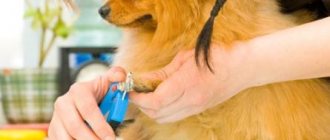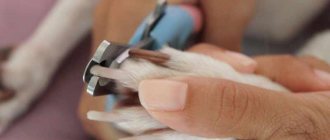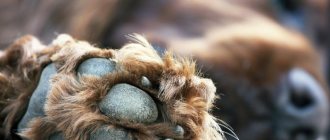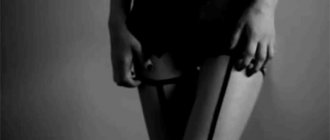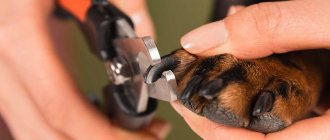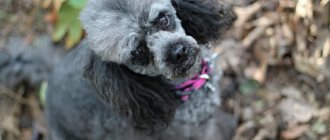Quite often, dog owners encounter problems when trying to trim their animal. Usually a calm and friendly dog reacts sharply to scissors and clippers, spins around and does not let itself be handled, growls and shows its teeth. This behavior is not considered normal and indicates major psychological problems in the puppy.
In most cases, the causes of aggression during grooming lie in childhood. The puppy was simply not trained to this procedure according to all the rules, they were not shown how to behave, or they caused injury through their wrong actions.
To cut or not to cut your dog?
Some dog owners who have never had their dogs cut are at a loss as to whether their pets really need a haircut. This question does not have a clear answer. There is still heated debate around this topic. Some dog breeders are confident that this is an unnecessary and even harmful procedure, while others consider grooming to be as necessary a component of dog care as brushing teeth and ears.
Arguments for: why does a dog need a haircut?
Animals need a haircut for:
Arguments against: why you can’t cut your four-legged pet’s hair?
For these animals, wool is a barrier that protects from precipitation, sun and insect bites. A cut dog can tolerate heat much worse than its uncut relatives. A short-haired dog runs the risk of suffering from solar dermatitis, malignant and benign neoplasms on the skin.
An unscrupulous or inexperienced groomer in the process of work can accidentally injure a four-legged client and introduce an infection into the wound. Some dog breeders who oppose this procedure claim that the animal experiences severe stress during it. When answering the question of why to cut these pets, you can be guided by the opinion of the majority of veterinarians, who do not recommend resorting to this manipulation without special indications. There are dog breeds for which grooming is contraindicated.
How to trim your Yorkie's face and head
There are approved rules for cutting a Yorkie's face, which many owners adhere to.
There is no need to cut the distance from the nose to the bridge of the nose. At this point, the hair will grow over time and lie neatly along the parting. To smooth out growing stray hairs, just comb them regularly.
The lower part of the muzzle can be shaved with a clipper with a nozzle from 2 to 5 mm. From the jaw line, the hair is carefully trimmed with scissors.
To give your Yorkie's head a perky, rounded shape, you need to carefully comb the hair on it in the direction of hair growth
Then cut it off, carefully moving from the eyes to the back of the head. In this way, first one side is cut, then the other. At the end of the procedure, the chin is trimmed
At the end of the procedure, the chin is trimmed.
Overgrown hair on the head from the bridge of the nose to the top of the head can be gathered into a ponytail and secured with an elastic band or hairpin. This option is suitable for Yorkie girls, who are often left with some of their long hair to create different hairstyles. For boys, you can make a completely rounded head shape.
Is it possible to cut a dog's hair yourself at home?
You can learn how to cut your pet's hair at home. Master classes will allow you to learn the intricacies of dog grooming (see video). They will help novice groomers learn how to create a dog's hairstyle and choose the right tools for the job. Before grooming a dog for the first time in his life, it’s better for a beginner to watch how they do it in a salon.
What tools will you need?
Owners of these animals who decide to cut their pet’s hair themselves need to acquire:
Premium-class clippers with many attachments and additional accessories are suitable only for dog owners who are familiar with the basics of working with them. For home grooming, a simple electric dog clipper is sufficient.
Rotary machines, powered by electricity, are powerful and can handle even the most unruly hair. They are completely silent, so there is no risk of scaring the dog with a loud sound. Vibrating electric clippers are usually used for grooming miniature, fine-haired pets.
How to prepare a place for a haircut?
A special groomer's table or a regular table, or in general any horizontal surface, is suitable for work. It is important that the groomer is comfortable and does not have to stand on tiptoes to reach the animal, or, conversely, bend over or squat. Frequent changes of position and uncomfortable postures can lead to the scissors or clipper falling out of your hands, becoming unusable, or, much worse, injuring the dog.
Dog grooming rules: algorithm of actions
To cut your dog's hair beautifully, you must follow certain rules. Dog grooming technique:
Features of the structure of claws in dogs
When the structure of a dog's limbs is examined, the shape of the claws can also be determined. There are different types of claws:
- the tips are bent so the shape becomes cat-like;
- in the shape of an arc;
- straight with a sharp end.
The first and second types of claws are typical for service or guard dogs. The third type is most often found in terriers or toy breeds. Claws are a means of movement; such an organ has its own functionality. We can give the simplest example: a dog digs the ground, its claws have auxiliary functions.
If owners decide not to trim their nails, then they should understand the consequences of their choice. If the animal is active and walks outside every day, then there will be no consequences, however, if the dog is a decorative breed, then the situation will become critical:
- Serious changes will begin in the musculoskeletal system. Claws that are too long will make it difficult for the dog to move, and it will feel discomfort. This can lead to clubfoot, because with minimal growth of claws, it will be difficult for the pet to move and it will deliberately try to lighten its load. Then deformation changes will begin in the joints, then in the paws and spine.
- There is a risk of injury to the animal. All owners of these pets are aware that dogs of purebred origin have four toes on their hind legs. Two fifths of the fingers do not touch the ground, thereby not being worn down. Hence the risk of injury arises; this claw can simply get caught on something and the animal’s soft tissues will rupture.
- The animal loses its sense of balance when it runs. Thanks to short nails, the dog receives another support while moving, while long ones interfere with the fingers and twist them.
- It will be uncomfortable for your pet to walk on a surface covered with linoleum or parquet, because the claws will knock.
To avoid such cases, you should know how to trim a dog's nails at home.
Possible problems
No matter how correctly the job is done, you may encounter a number of problems in the process of grooming your pet. You can solve them if you know how to act in a given situation. What to do if the dog becomes aggressive and bites? What to do when your dog won’t let you cut his hair? How to cope with grooming an animal whose fur is very fluffy and very tangled?
What to do with an aggressive, biting dog?
Before starting the procedure, the dog needs to be walked and fed. It would be a good idea to give him some kind of treat. Excitement, screaming, sudden movements can quickly be transmitted to the dog, making it angry. If during the procedure the pet becomes aggressive and biting, attempts to cut it should be stopped and your four-legged friend should be calmed down. You can try to cut the animal again no earlier than in a week.
During this period, it is necessary to accustom him to good behavior during any manipulations with the fur. While pretending to cut the dog's hair, the owner should treat him to something tasty. There are dogs that only experienced groomers can groom. These are representatives of the dominant and nervous types. Large and particularly aggressive dogs are muzzled before the procedure begins.
Some owners of four-legged aggressors have the idea of putting them to sleep during the procedure. However, veterinarians do not recommend resorting to such a measure.
What to do if a naughty dog is not given a haircut?
Why doesn't my pet allow itself to be cut? If a dog does not give in and actively struggles when trying to approach it with scissors or a clipper, most likely, it is simply afraid of strange tools and does not understand what they want to do with it. In this situation, you need to do the same as in the previous one, i.e. postpone the procedure for a while and gradually accustom your pet to actions with its fur.
The dog will eventually relax so much and get used to the constant manipulation of his fur coat that he will calmly take the haircut. Sometimes animals become very nervous and cannot be calmed down. Then you cannot do without the use of light sedatives.
How to trim a very neglected dog?
The only way to deal with a neglected dog whose fur is very matted and tangles have formed all over his body is a clipper haircut. The pet will not become bald after this procedure; the machine will only remove all dense hairballs. The height of the coat of a dog with a clipper will be from 1.5 to 5 mm. If it is healthy, it will grow quickly and evenly.
Actions to take when bleeding from a claw
To reduce the risk of damage to the claw, trimming should be done regularly using a special guillotine tool. If blood does appear on the claw, measures should be taken as quickly as possible. An open wound can become infected, and bacteria getting under the claw can lead to suppuration and, in severe cases, blood poisoning. Severe bleeding is dangerous; in such cases, it is better to immediately take the dog to a veterinary clinic.
You can deal with damage in the following ways:
- If, after trimming the claw, a dark spot of a blood vessel is visible on the cut, but no blood flows, you can limit yourself to disinfecting the wound with any suitable product - alcohol, vodka, hydrogen peroxide, iodine or brilliant green. If the dog limps when moving, it means that it is in pain and has damaged nerve endings. The claw can be carefully sealed with a textile adhesive plaster or the dog can be put on special boots until the plate grows a little and the pain goes away.
- If there is bleeding, the most effective method is to use dry powder of potassium permanganate (“potassium permanganate”). The damaged area is simply “dipped” into the powder or applied to the wound using a cotton swab or match. The crystals promote rapid blood clotting and thrombosis of the vessel. The blood stops flowing. The damaged area should be covered with a sterile bandage, especially if the animal lives in a booth outside and runs on the ground. The next day, if there are no problems, the bandage or “boots” are removed.
- Another simple and radical remedy is alum or a special hemostatic pencil. You can buy it at any pharmacy and always keep it on hand for such cases. Like potassium permanganate, products based on burnt alum stop bleeding almost instantly, forming a dense clot. The pencil is simply pressed to the cut site and held for a few seconds.
- You can replace potassium permanganate and pencil with talcum powder or baby powder, but these products are less effective. Streptocide powder or any powdered antibiotic is suitable, but these products are effective only for minor injuries.
- A small cut without significant bleeding is cauterized with hydrogen peroxide or chlorhexidine.
- In an emergency, you can use folk remedies: crystalline sugar (used in the same way as potassium permanganate), as well as juice from nettle leaves, berries and viburnum leaves. They contain vitamin K, which promotes blood clotting.
All these methods are effective only if a small vessel is cut or the bleeding is not too active. A very high cut plate threatens severe bleeding, as does a claw that is accidentally torn off, so after the initial treatment the dog must be shown to a veterinarian.
Before performing the procedure, you need to take care of the cleanliness of the dog’s paws and disinfect the tools. This will reduce the risk of infection if the capillary is damaged. Experienced breeders recommend not trimming before important events and exhibitions, the dog may become lame.
With proper regular pruning, the animal behaves calmly, and the risk of damage to blood vessels is minimized.
Which dogs need sedatives for grooming?
If you have a fussy dog, you may be wondering what calming medications you can give him to help him feel better about being groomed. Careful consideration is required before deciding to go this route as there are several options. You should ask yourself the following questions before asking your veterinarian about sedatives:
In general, sedatives should be used as a last resort when all other options have been exhausted, and in those special cases where the dog is affected by severe anxiety that does not respond to behavior change, or when there is a risk of defensive bite.
Treatment of wounds
If you accidentally touch the pulp and bleeding begins, you should calm the animal and then treat the wound:
- Wash the damaged area with hydrogen peroxide or iodine.
- Apply a weak solution of potassium permanganate to a cotton pad or piece of gauze and apply to the wound. Hold for at least a minute.
- Press the powder onto the tip of the nail and hold until the bleeding stops completely.
It is advisable to keep the dog away from water on this day so that it does not introduce an infection into a fresh wound.
If nails are trimmed regularly, the pulp gradually retreats, which simplifies the process and reduces the likelihood of injury to the animal. Sometimes the pet is given a sedative before the procedure or if there is serious damage to sensitive tissue. A veterinarian should prescribe such drugs.
- How to clean a dog's ears?
- Papillomas in dogs
- Dandruff in dogs
Types of sedatives for grooming
If you have already tried several options and found that yes, your dog definitely needs sedation, you will need to contact your veterinarian or veterinary behaviorist for the most appropriate drug. While deciding what type of drug to use is beyond the scope of this article and should be strictly at your veterinarian's discretion, working alongside veterinary behaviorists and general veterinarians, I would like to point out a few common cases.
Requirements
According to the requirements of the breed standard, certain evaluation criteria for appearance are established for the Miniature Schnauzer. For exhibition, the dog must be trimmed in the back area, from the back of the head to the croup. The rest of her body can be trimmed.
It is worth considering why trimming is used. The peculiarities of the coat of some dogs, which include the miniature schnauzer, imply faster growth of guard hair with a relatively short and weak down. Since the fur not only forms, but also dies, its abundant retention on the body interferes with the normal formation of a new coat.
The dog looks sloppy and significantly loses its appearance - in comparison with its brothers freed from excess undercoat. The hard awn, due to the lack of shedding, also looks unpresentable and loses its shine and shine.
The multi-layered coat of a miniature schnauzer is associated with the unevenness of its growth. Mature, ripening and young awns remain together on the dog's back and need to be thinned out. When trimming, a special knife is used to pluck out exactly those hairs that are no longer needed. When shearing, the fluff is simply cut off completely, the fur does not look natural, which is very noticeable in the ring. The exhibition length of a Miniature Schnauzer’s “coat” should be no more than 1.5 cm.
When carrying out trimming, it is important to remember to adhere to deadlines. When preparing for an exhibition, the first treatment is carried out no less than 60 days before the show, and the second treatment is carried out 2 weeks before. This allows you to achieve the correct length of hair on the back, ensuring the preservation of the aesthetics of the breed within the current standard.
In black dogs with a brown undercoat, the intensity of hair growth is higher - they need trimming up to 7-8 times a year, every 1.5 months
This allows you to achieve the correct length of hair on the back, ensuring the preservation of the aesthetics of the breed within the current standard. Black dogs with a brown undercoat have a higher intensity of hair growth - they need trimming up to 7-8 times a year, every 1.5 months.
Acepromazine
After unsuccessful attempts with Benadryl or melatonin, some veterinarians recommend Acepromazine. Now, this is a much more potent drug, but with higher potency there is an increased chance of side effects . This drug can cause what is called a paradoxical reaction, which means that it causes the opposite of what the drug is intended to do. In this case, instead of relieving anxiety, your dog may become hyperactive and even aggressive!
General anesthesia
In severe cases, the dog may need to be placed under general anesthesia for grooming. Of course, this is done at the veterinarian's office. This is often done in cases of overly fussy dogs, or when there may be pain or a need for the dog to remain still for long periods of time. An upset dog or cat full of painful mats may be better off being placed under itself rather than being forced to remain motionless and in pain for some time.
Breeds that most often need grooming
All dogs require special care, regardless of size, coat type, living conditions, etc. Even stray dogs monitor the condition of their fur on their own or with the help of their friends. If you do not regularly care for the fur, it can become tangled and matted, which will cause significant discomfort to the animal.
Every pet needs minimal care:
- regular brushing;
- eliminating wool defects;
- trimming claws, etc.
These and more complex procedures (such as a model's hairstyle) are best left to a professional groomer. Most often, its services are used by owners of decorative, small and medium-sized breeds. In most cases, these dogs require special grooming depending on their coat type.
Sedatives and Drug Alternatives for Grooming
Need to care for your dog, but are you too keen on your veterinarian prescribing medications? After all, drugs can have side effects, as you know, and won't cause the problem. Research shows that drug therapy is rarely a cure on its own and in most cases is indicated only as an adjuvant therapy in a behavior modification program. So you may find some natural sedatives to be a better option.
Other sedatives include products such as
DAP collars that contain calming “seductive pheromones” may also be helpful. You can try a collar, atomizer, or diffuser.
These sedatives may not be suitable for grooming at a groomer, but they can work with behavior changes that you can begin at home and at your own pace. Let's take a look at how I work with fussy dogs to make grooming more acceptable.
How to properly trim a Yorkie's head
A Yorkie's first haircut is done at about 3-4 months of age. For a puppy's haircut, it is preferable to choose a classic or hygienic one, since its main purpose is to ensure the cleanliness and comfort of the animal.
Haircuts for adults are very diverse. There are many options for fashion haircuts, but for show dogs it is preferable to trim and contour with thinning scissors to get rid of split ends.
- on the back of the nose;
- under the lower jaw and along the line of the mouth;
- in the area around the eyes;
- in the upper third of the ears (in puppies up to the middle of the length of the ear), giving a V-shape;
- remove with a trimmer or tweezers from the inside of the ear;
- and also create the contour of the head.
How to Brush a Dog That Hates Being Brushed
My behavior modification protocol for dogs who want to be groomed includes 3 steps:
We've already seen calming treatments, so now let's move on to the process of getting a dog that you're used to caring for and even enjoying. But first, let's look at some basic facts:
Now let's move on to other components to change the behavior. Desensitization: This is a process where you make fear less intense in your dog through very, very gradual exposure. Please read this guide to learn more about how this process works: Dog Desensitization The desensitization process generally doesn't work very well unless you use another behavior modification technique known as counter-conditioning. Essentially, this process entails changing your dog's emotional response to grooming. If, say, your dog is afraid of brushes and the sight of it makes him shiver, then you will make him love brushes, and the sight of them might make him happy. Here's how the process works: Now let's put it all together: So you would first start using a sedative of your choice to help take the edge off. This could be a soothing chew, a DAP or Thundershirt collar, or a Wrap Of Wrap. Next, you would start using desensitization and counterconditioning. To make this easier, below are some articles that provide detailed step-by-step instructions on how to achieve this:
So, let's say your dog is afraid of the brush because he associates it with grooming and all the other unpleasant sensations, and you will begin to gradually introduce it and create new positive associations. Here are some tips:
Source
Guys. It's honestly boiling over.
I work in one of the zoo hairdressing salons in my city.
A groomer's assistant. For those who don't know what it is, please google it if you are interested in more details, but in general, a groomer, if you don't pick on all the little things, is a person who gives haircuts to dogs, cats and other living creatures that can be given beauty.
My task as an assistant groomer is to scaffold somewhere, help somewhere, and help the groomer somewhere if the dog comes in active.
We have many clients who are understanding, some who are not so understanding, and some who are not at all adequate.
For some reason, they don’t understand that a dog or cat is first and foremost an animal, and I don’t know where they live, so in order to protect myself, I put on all sorts of devices, an apron, gloves, masks to protect YOURSELF. And it begins that you are disdainful or what? Our musky is kept in first-class conditions and blah blah blah... we start shearing and then the fleas come down. and the hostess looks in disbelief, WOW SHE’S A HOMEMADE.
Complications after haircut
A dog that is not accustomed to standing still during a haircut, even in the skillful hands of a groomer, can twitch at a crucial moment and provoke a cut or other trouble .
The cut will be treated with an antiseptic, but the aftereffects of other troubles can make themselves felt after some time and scare the owner with the pet’s strange behavior.
There was a case when, after another visit to the salon groomer, a Pekingese couldn’t go “big” for a day - he sat down during a walk, “put his tail” under himself, whined pitifully and looked reproachfully at the owner. The owner's heart was breaking; she did not understand at all what was happening to the dog. Later, experienced “colleagues” suggested that this strange behavior was a reaction to damage in the groin area during haircuts , as well as hair cut too short in the genital area. It took a week of treatment with antiseptics, persuasion and caresses during daily hygiene procedures to remove the consequences of an unsuccessful visit to the salon.
Important: for some dogs, especially males, it is not recommended to shave the hair in the groin area very short, “to zero.”
Similar behavior of the dog - strange sideways jumps, constant squats, a desire to hide - was also described by the owner of a cocker spaniel. Each time after a haircut, the dog needed time to recover.
He didn’t have any pain, he just felt uncomfortable with his hair cut, he was embarrassed and suffered from the “humiliation” he experienced.
But the essence of a proper haircut is precisely that the dog should not experience humiliation and psychological discomfort . And there should be extremely pleasant sensations. And this is achieved in only one way - love for the animal, and with the only message - to do good to him: so that his eyes look, his ears don’t itch, his paws don’t hurt, nothing bothers him anywhere, and they turn around after your dog in admiration: “Ah! What a beautiful girl!"
And kind words, as you know, are pleasant to a dog.
Vegans, enlightenment and a tea bag
My colleague hung up. After talking with the guest from room 815, Renat looked very surprised. -Alex, they are asking for a senior about a tea bag. -What?
We looked at each other and started laughing, remembering the Nigerian film “Awesome Transport”.
The time was approaching two o'clock in the morning and smoking guests periodically scurried through the silence of the first floor hall, past the reception desk. Someone was shuffling along the marble in white fluffy slippers, not wanting to change into street shoes. The automatic door of the central entrance began to rotate, letting the courier through. A young man with a package came up to us and lowered his load onto the counter. -Good evening, food delivery to room 815 for Lisa. They asked to leave it at the reception. -We do not deliver parcels or food products. Call the customer, they should meet you.
Muttering something similar to “dapoh,” the boy left. Renat and I looked at each other and decided to hell with him. You still have to get up at the guest’s request. Having decided that since there is nothing to do, we will go together and speed up the process. Perhaps the woman needs to replenish the supply of tea bags in her room. I grabbed the bag with the boxes of food and we headed to the elevator. Renat went to the housekeeping warehouse to get tea and a couple of bottles of water for the guest, and I went to her room. Stopping in front of the door, I straightened my tie and knocked. -Good night, receptionist. You asked me to come over... -Yes, I did! This is barbarism and disgrace!
The disgrace is that I again observe a pretty woman in lingerie while working. Slender body, hieroglyph tattoos. Tunnels in the ears. Maybe some kind of obsessed with the East or yoga? The mantra “om namah shivaya” was heard from a portable speaker in the room.
-My name is Alex. Elizabeth, I would like to clarify what you consider barbarism and disgrace? -Tea station! You have tea bags from manufacturers who use plastic raw materials. I can't drink this. Along with natural fibers, the tea bag also contains plastic fibers! True, there are also bags made from natural raw materials, but here the thread is glued to the bag, and not attached with a paper clip! And they use glue containing casein. Right now, for a month, I have not consumed animal products. Therefore, this is not acceptable for me, and a hotel of your level does not offer an alternative.
All this time, she continued to shake a wet bag of green tea, which I did not immediately notice. Damn vegans. Renat peeked out from behind me, rustling tea bags. After a short “oh them.. Hello,” he froze.
-The courier handed over the order to you, we usually don’t deliver it, but as an exception to the rule. It is for you. In the future, you will need to go down and meet him. As for tea, I can offer you brewed tea from the room service menu, at the establishment’s expense. Please choose what you need and we will deliver a supply of tea leaves and a teapot to your room.
With the words “thank you, savages,” she put a wet tea bag in Renata’s palm and closed the door. We looked at each other and walked towards the elevator. Suddenly, the door behind me opened again. We turned around. Our friend walked towards us with a confident step. There was determination on his face. She was holding a delivery box in her hands. After a couple of seconds, she shook it out in front of me. I looked at my shoes covered in rice and some shrimp.

